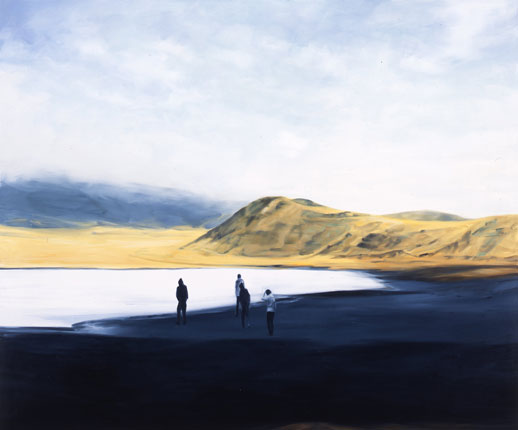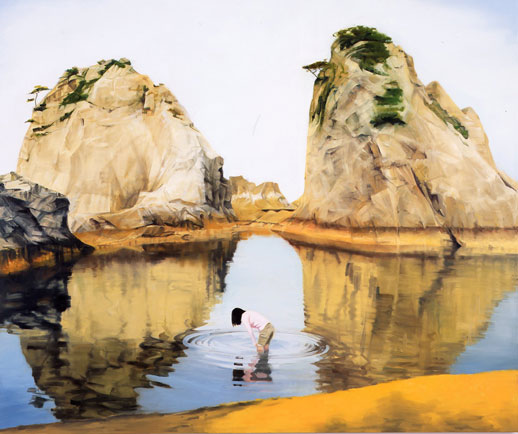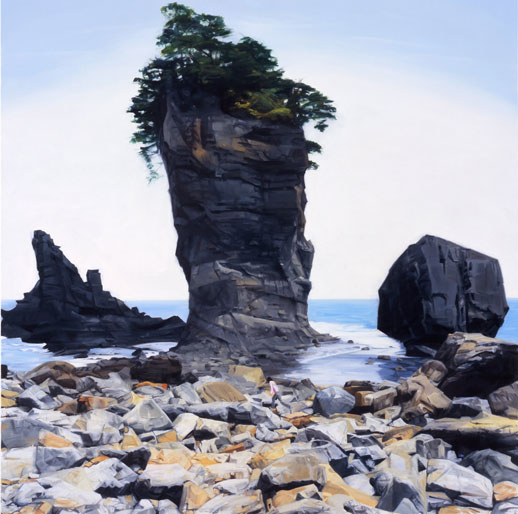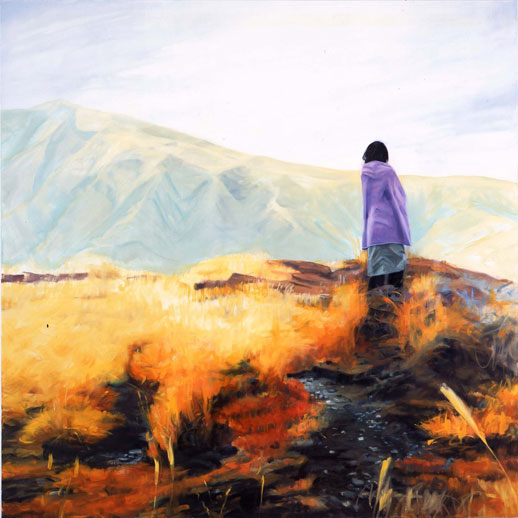Paintings of “Nowhere in Particular”

Your paintings have a very distinctive atmosphere. When did you first begin working on the current series featuring people within natural landscapes?
I had been experimenting with these kinds of paintings since I was a graduate student in Baltimore, US. I started consciously working on this theme from 2003, after I came back to Japan. I am often told that my paintings have a distinct mood, but I don’t really think about these things when I paint, it just happens.
What is the process that you take when doing a painting?
My paintings are largely based on photographs. I used to create an image in my head of the kind of painting I want before going out to find places that fit this image. But recently, I find a location first, and try to get inspiration from the place itself when I actually go there to take pictures. I always choose locations that have a certain appeal and draw me in, but I don’t really have a clear image of what sort of painting it will become while I shoot. It’s only after I come back home and stare at the printed pictures that I see a potential painting, and this image becomes solidified when I started putting paint to canvas. I try not to dwell so much on technical aspects such as colour or shadows and so on.

Do you have a certain criteria when choosing a location?
Recently I’m choosing dynamic, out-of-the-ordinary places. Often I hear about a good place from a friend, or I’ll come across a striking photo in a magazine or something, and decide to go. I try to choose locations that don’t reveal their historical backgrounds or localities, and don’t specify “where” the place actually is. Sometimes I capture the mood that I want to paint on camera perfectly, while other times I trim the printed photographs to artificially create a “nowhere in particular”.
I once did a series based on photographs of traditional Japanese gardens. Japanese gardens are elaborate “natural” constructions made by humans, almost like a theatrical set, so in that sense it’s the complete opposite to the natural landscapes in the current exhibition. That series was based on the idea that it would be interesting to paint very prim traditional gardens using bright, artificial colours, like candy.
Judging from your paintings, it seems like you’ve been to a lot of interesting places…
Yes, especially recently. I often go to a place and stay for 2 nights or so, and shoot photos. I like traveling for photographs because I have something to look forward to when I get home. I also travel for pleasure, but I end up location-hunting anyway, since I’m already there and it saves paying for another trip.

Your paintings often feature people. Is there any significance in this?
By featuring familiar objects such as people or huts, for example, they act as a bridge between the different worlds of “this side” and “the other side”. If there aren’t any people to look at in the paintings they merely become grand landscapes, but what I really want to do is to portray an ordinary person in an extraordinary setting. That way, the characters act as touchstones to draw the viewer in, so that they can connect to the paintings more easily. Also, I usually choose one or two people in the photos that I take – often tourists – to paint in, but I try to make sure that it’s not evident why they are in that particular location, so as not to restrict the interpretation or meaning of the painting. I’m not too picky with the characters I choose, especially as they often have their backs to the audience or I don’t draw their faces in, but I realized that I seem to subconsciously be choosing people my age. You don’t see any children or elderly in my paintings.
What other sources of inspiration do you have?
Right now I’m really into the artist Peter Doig. When I see his paintings I realize that anything can be used as inspiration for an artwork. For example, Doig saw the film Friday the 13th, and he was inspired to do a painting based on the film that night. Of course, the finished piece had little to do with the film itself, and that in itself is quite interesting. I feel comforted by the fact that artists like him draw inspiration from almost anything.

What are you working on right now?
Recently I’ve been wanting to paint portraits and focus on people more. I used to paint a lot of portraits when I was a student, and I feel like going back to that. I tend to get ideas by painting and sketching a lot, so right now I’m drawing a lot of small paintings based on anything I can lay my hands on – often old photographs lying around that I rejected for past works. I did a small series of portraits as an experiment, and again, these are all based on photographs. They are portraits that can only be captured on film: the moment someone blinks, or a blurry image of someone shaking their head. I’m experimenting with different coloured paints as well, and my favorite right now is fluorescent pink! I like it because it’s so vivid, and I’ve actually used it a couple of times with the paintings in the current exhibition as well. I also have silver paint but I’ve yet to use it, as I’m not sure how. Although I still love painting nature and will continue to do so, right now I feel like painting people.
Your exhibition “nowhere in particular” is being held at two venues, Arataniurano and Dai-ichi Life Gallery. What should visitors especially look out for when seeing your paintings?
My paintings look very photorealistic on the flyers or on the web, but the actual paintings are quite large and painterly. I’m often told that my paintings are almost like photos, but if you see them up close, they are quite rough. I am a big fan of paintings, so I want to maintain this painterly feel to my works as much as possible. The Dai-ichi Life Gallery is showing my larger works, so it would be great if people go to both exhibitions if they can.
English Translation: Lena Oishi
Lena Oishi
Lena Oishi



